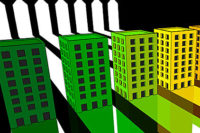According to the organization Architecture 2030, there was approximately 275 billion sq ft of building stock in the U.S. as of 2010. They estimate that on an annual basis, roughly 1.75 billion sq ft is torn down, 5 billion sq ft is renovated, and 5 billion sq ft is newly constructed. Using these approximations, it can be reasoned that perhaps 70% of our building stock will still be standing 20 years from now, affording us a great opportunity to reduce energy consumption. Fortunately, the EPA has existing buildings covered as well through the Energy Star Program’s Portfolio Manager. Using the Portfolio Manager is a recommended first step when embarking on an energy conservation program, since it will tell you how your building compares to other similar buildings in a process known as benchmarking.
BENCHMARKING
Inputting some basic information into the Portfolio Manager such as building type, sq ft, number of occupants, hours of operation, and utility bill data allows Portfolio Manager to generate a building score between 0 and 100. This score is normalized for weather. A rating of 50 indicates that the building performs better that 50% of similar buildings nationwide, and a rating of 75 or greater allows the building to qualify for the Energy Star label. A building with a low score would likely provide ample opportunities to save energy at that facility and warrant spending time looking for ways to reduce energy consumption there.
The DOE’s Energy Information Administration conducts a national survey every four years and compiles information on building characteristics and energy use from thousands of buildings across the U.S. The survey known as the Commercial Building Energy Consumption Survey or CBEC, is a powerful benchmarking tool. Although there have been issues with its recent survey, the 2003 database is widely used. The benchmark metric is energy use intensity (EUI), which has the units of thousand Btu/sq ft/yr. Buildings that have a high EUI compared to a peer group are good candidates for energy auditing.
ENERGY AUDITING
The margins are slim in the field of energy conservation, so the name of the game is to avoid wasting time and money traveling down roads that to do not lead to savings. The goal is to focus resources where they can have the most impact by maximizing the return on investment (ROI). It may be tempting for a building owner to embark on an energy conservation program that begins with extensive energy audits of all the facilities in his portfolio, which would be a mistake as audits can be expensive. Start with benchmarking. Once this process has identified poorly performing facilities, they can then be scheduled for an energy audit.
ASHRAE defines three levels of energy audits, as shown in the sidebar, with Level I and II audits being the most common. A level III audit might be conducted when there is a lot of money at stake such as with larger energy-intensive facilities that that are performing well below expectations or when a performance contract is to be employed that bases financial outcomes on energy savings.
When searching for energy savings, it is prudent to focus on the building systems and components that are likely to consume the most energy. To facilitate this, it is recommended to estimate the energy use by component such as lighting, space heating, cooling, water heating, and processes. Lighting energy is usually the easiest to estimate since it involves counting luminaires and making assumptions on the number of occupied hours. Subtracting the estimated lighting energy from the electric utility bills yields the amount of electricity used by everything else. Figure 1 shows typical office energy consumption by component according to CBECS 2003 data.
Although the building envelope does not consume energy, its components, e.g., walls, roof, windows, doors, and shading devices, do impact consumption. Altering an existing building envelope can be a complicated matter and is outside the scope of this article, but it should be mentioned that it makes sense to evaluate the impact of added roof insulation on the life-cycle cost of the upgrade at the time of a building’s roof replacement.
A category of energy consumption that the building owners and tenants directly control is the process load, which in an office building can be composed of computers, copiers, printers, and monitors. Although a consultant can recommend Energy Star products, it is usually the responsibility of others to evaluate and implement. HVAC and lighting systems often present the best opportunities for energy savings in commercial buildings.
HVAC SYSTEMS AND RETROCOMMISSIONING
Energy auditing can reveal a wide range of improvements to a building’s HVAC systems from capital-intensive replacements to the so-called low cost/no cost items. These latter audit findings are also referred to as the “low-hanging fruit,” and since there is no point in waiting around to implement these energy saving solutions, retrocommissioning can be used to expedite the process.
Retrocommissioning is a super strategy for energy conservation, as it couples elements of an energy audit with some hands-on tweaking to yield immediate energy savings. In addition to a thorough building survey, retrocommissioning should begin with interviewing key maintenance personnel as well a review of utility bills for the past several years. These tasks are similar to those associated with energy auditing efforts such as identifying energy conservation measures. A major distinction, however, would be that the commissioning work would stop short of implementing major capital improvement projects. The focus instead would be to institute processes that improve and optimize the operation and maintenance aspects of a facility.
A common finding in retrocommissioning work is that some newer facilities, especially laboratories and hospitals, are over-ventilated, which may be due to the conservative approach of some engineers. A related phenomenon is the occurrence of excessive simultaneous heating and cooling, since over-ventilation will require additional reheating to maintain the space temperature setpoint. During unoccupied times, lighting is either at reduced levels or turned off and heat-generating equipment is typically shut down, all of which forces additional reheating energy to be expended. This overlap of heating and cooling is equivalent to driving a car while pressing both the gas pedal and brake simultaneously. Simultaneous heating and cooling can also be found in AHUs where both the hot water and chilled water valves are open or when the airside economizer is operating improperly by depressing the mixed air temperature, which then needs to be heated to maintain the supply air discharge air temperature.
Time of day scheduling is also another area where retrocommissioning can yield dividends. This should include scheduling of large systems such as central station AHUs, as well as items such as general exhaust fans. Once proper time of day scheduling is established, setting the unoccupied setpoints to say 85ºF in the cooling season and 60ºin the heating season will compound this energy savings. Less popular is the strategy of globally altering and fixing the occupied temperature setpoints, cooling at 75ºand heating at 70º. Overpumping of heating hot water and chilled water systems can be a common occurrence in any facility, with the tell-tale symptom of low temperature differential. If pump discharge pressures are high, perhaps the distribution pumps were oversized and are now overpowering the control valves and not allowing them to throttle closed.
In the realm of capital improvements, energy savings measures can run from wholescale HVAC system replacement down to minor system modifications and improvements. Motor replacement is one way to gain incremental energy savings without overhauling the entire HVAC system. Not only can higher efficiency motors be installed on pumps and fans, but an analysis may show that certain motors are oversized for the duty and can be replaced with smaller motors, which will then operate closer to their peak efficiency.
Another common system improvement is to install VFDs to modulate the output of air handlers and pumps. It does not always make sense to do this, however, as some systems may have a service that does not vary much, such as in an air handler that serves an interior office space. It is recommended that the motors be replaced in older systems with ones compatible with VFDs, or motor failure may result. Improvements such as these are often eligible for utility company rebates, which can improve the ROI.
LIGHTING SYSTEMS
Twenty years ago, HVAC designers would use 2 W/sq ft as the lighting energy budget when doing cooling load calculations, whereas today they might use half of that due to advances in luminaire and lamp design. However, according to NEMA, there might still be a half-billion T12 lamps with magnetic ballasts operating in U.S. buildings that could be replaced with T8 or T5 lamps. Considering that lighting can often account for roughly 40% of the energy use in a typical commercial facility, this could save a lot of energy, not to mention cutting mercury content in half.
Last year, it became illegal to manufacture or import 1 and 2 lamp replacement T12 magnetic ballasts, and by July 2012, standard T12 lamps will no longer be made in the U.S. As a result, this has become not only an energy issue but an O&M issue as well. By switching from T12 to T8 luminaires you can expect to reduce energy consumption by roughly 30% and increase lighting levels by 20%. On large, open areas, it might make sense to forgo doing a direct replacement; the space may not need as many of the new luminaires due to their improved efficiency. Employing a lighting certified (LC) professional would be prudent in these cases.
Evaluation of how a space is used and what control scheme can maximize energy reduction is perhaps the most effective means to reducing lighting load. Dimming, occupancy/vacancy sensors, relay controlled time of day switching, and daylight harvesting are the most commonly implemented lighting control systems. Dimming lighting loads down to the desired light output has a direct correlation to the amount of energy consumed. While dimming fluorescent lamps will not yield a direct linear energy reduction like incandescents, it is very close (dimming a fluorescent lamp by 80% eliminates 85% of energy use). Occupancy/vacancy sensors help ensure the lights are never left on when a room is unoccupied. Often these are also incorporated with multiple levels of control allowing users to reduce light output and load when high levels are not necessary.
Time-of-day or relay-based switching is a means to automate the lighting controls for general spaces where occupancy sensors could be distracting or impede typical operation of the space. While a standard time-of-day relay-based system will not be as efficient as occupancy sensors, various control devices including occupancy sensors, daylight harvesting photocells, and astronomical time clocks as well as energy management software can be incorporated into more complex systems allowing total control over a complete lighting system through relays.
Daylight harvesting is perhaps the most effective means of reducing lighting loads in spaces where applicable. The majority of commercial buildings are operational during daylight hours, so utilizing this natural daylight to illuminate the interior of buildings is an excellent solution. There are several factors that affect the efficiency of a daylighting system including exposures, size of windows/skylights/curtain walls, transparency of glass, utilization of automatic shades, switching or dimming system, and the general use of a space. When effectively implemented, a daylight harvesting system will seamlessly integrate into a space and have no detrimental consequences to the occupants while maintaining the light levels necessary and reducing energy consumption.
CONCLUSIONS
When confronted with the task of saving energy in a commercial facility, start with benchmarking before proceeding with any type of energy audit. Lighting systems can provide ample opportunities for savings, and look to retrocommissioning for quick rewards in reducing HVAC system costs. ES





